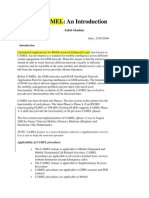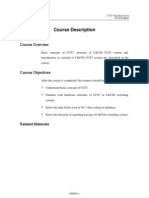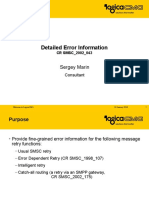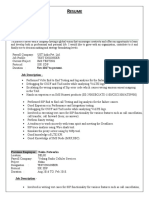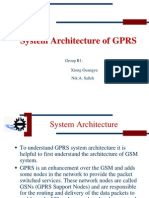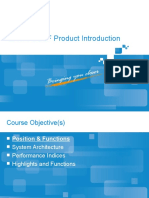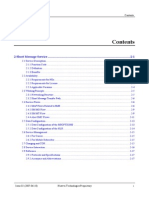BICC Vs SIP
BICC Vs SIP
Uploaded by
Xuân ToànCopyright:
Available Formats
BICC Vs SIP
BICC Vs SIP
Uploaded by
Xuân ToànOriginal Description:
Original Title
Copyright
Available Formats
Share this document
Did you find this document useful?
Is this content inappropriate?
Copyright:
Available Formats
BICC Vs SIP
BICC Vs SIP
Uploaded by
Xuân ToànCopyright:
Available Formats
BICC vs SIP-I BICC (Bearer Independent Call Control) and SIP-I (Session Initiation Protocol ISUP) are session
n control protocols, which are used to create, modify and terminate IP based communications such as voice and multimedia services. Both methods are developed to carry ISUP signalling messages over IP based networks. Different releases of 3GPP adapted both these protocols in order to cater the evolving networks and their interworking. BICC BICC was defined to cater ISUP signalling based services over broadband backbone network. Since ISUP was designed to cater narrowband signalling requirements over TDM networks, BICC specification was defined and standardized by ITU-T as per the recommendation Q.1902 in year 2000 to create, modify and terminate voice calls between MSC servers (Mobile Switching Center). BICC handles the signalling part of the voice calls, which ultimately controls the bearer setup and disconnection. BICC inherits the message and parameter set of ISUP, which leads to compatibility and support of ISUP services. 3GPP (3rd Generation Partnership Project) adopted BICC in the UMTS Release 4 standard, which was published in year 2001. BICC addresses most of the requirements of GSM and UMTS domains, but failed to address the future flexibility requirements with the evolution of networks. BICC CS2 (Capability Set 2) comprised of the ability to control the IP bearer network, codec negotiation, and modification using the BCP (Bearer Control Protocol). This leads to separation of call control and bearer connection control into two independent networks within the UMTS architecture. SIP-I SIP-I is an extension to existing SIP protocol with encapsulated ISUP messages to transport narrowband signalling over SIP based networks. Both ITU-T and ANSI standardised the SIP-I specification to cater the interworking with ISUP and BICC networks. As per the SIP specifications, 3 profiles are defined to cater major interworking scenarios. For an example, Profile A support only ISUP services by mapping the ISUP information into SIP headers, Profile B provides generalized SIP solution with the ability to cover interworking between range of ISUP networks and Profile C covers regulatory requirements with encapsulated ISUP. SIP-I facilitates the interconnection with ISUP islands into the SIP backbone. Another advantage of SIP-I is the possibility to create trust domains, so that, any message received from that trust domain is assumed to be treated as valid network node, which is essential to cater the interworking with legacy ISUP networks. What is the difference between BICC and SIP-I? - Both BICC and SIP-I signalling can be used in Nc interface of NGN (ie. Between MSC server communications), and for the interconnection of IMS and NGN domains (ie. Between MSC server and MGCF). - Initially BICC was developed to cater the ISUP interworking in the GSM and UMTS domains, but due to the limited flexibility and evolution of the standard, SIP-I was
introduced to UMTS domain to cater the ISUP and SIP interworking requirements, which evolved with the networks. - Unlike SIP-I, there are some concerns about BICC for the interoperability across domains other than UMTS and GSM, therefore, later releases of 3GPP chose SIP-I over BICC. - 3GPP version of BICC is generally used by wireless operators, and leads to difficulties in interoperability with wired operators. This can be avoided by using SIP encapsulated ISUP, as standards for both wireless and wired operators are available. - BICC specification was initially used by 3GPP to facilitate the services such as packetized voice between UMTS call servers, while SIP-I was more focused on evolution of networks and facilitation of interworking. - BICC uses IuFP media packet framing protocol specified by 3GPP, while SIP-I uses packet framing based on IETF specifications, which is widely used between operators. - Further the media packet framing protocol used by BICC is less efficient when compared with SIP due to the duplication of some RTP layer functions on the BICC. - SIP-I was developed with the concept of trust domains, so that it will be better suited for UMTS networks as same as the BICC. BICC and SIP-I are mechanism to interworking and encapsulation of ISUP messages to transport over the IP based networks. In general BICC is limited to operation within GSM and UMTS context, while SIP-I provides interworking with most of the networks Read more: http://www.differencebetween.com/difference-between-bicc-and-vs-sipi/#ixzz2MDQJmQAg
1 Introduction VMS (VoiceMail System) is a basic value-added service of the communication network that provides many mailbox services to users, including voice mailbox, ad mailbox, fax mailbox and virtual mailbox. UMS (Unified Messaging Service), an information service technology, was proposed in the 1990s. It integrates different information services previously supported in different networks, for example, the telephone network, paging network, mobile network and Internet. In short, UMS can be regarded as an integrated mailbox, which stores various messages of different terminals. The objective of UMS is to break down the barrier between terminals and the media so that the user can communicate freely at any time, at any venue, and use any technology, media or terminal. The following is the general requirement model of UMS:
The concept of UMS was proposed in 1995. With the continuous development and improvement of related technologies, it has become a hotspot in the telecom industry.
Fig. 1 UMS Requirement Model According to the American research institute OVUM, it is estimated that by 2003, there would be 110 million people using UMS throughout the world, resulting in a market size of at least USD9 billion, and that by 2006, the market size would increase to USD31 billion. At present, 75% of the USD400 billion-telecom market in North America comes from valueadded services, in which UMS accounts for a large proportion. Many telecom operators from the developed countries provide UMS services to increase ARPU (Average Rate Per User). For instance, when a telecom operator in Sweden adopted the UMS system, with the provision of UMS service, the frequency of the users making fixed-line calls and mobile calls increased obviously and their communication duration increased accordingly. As a result, the ARPU of this operator increased by 70%. As ZXVMS system adopts the UMS structure, only adding Email server and Web server as well as some UMS functional software can upgrade it into a UMS system smoothly and conveniently. All UMS functions can be enabled. This article is going to introduce the architecture of ZXVMS/UMS first and then give a general description of the functions and services of ZXVMS/UMS. 2 Architecture of ZXVMS/UMS ZXVMS/UMS has a three-layer structure, comprising the access service layer, the application service layer and the background service layer. The access service layer provides users with flexible modes in accessing or visiting UMS. It realizes the access of various message media via the service gateways of SM, Voice, Fax, WWW and Email subsystems by complying with their application protocols. The application service layer provides specific application service logics. It receives the service request from the user, processes the request, and returns the message as per the users requirements. At the same time, it receives the updating information from various subsystems to register messages and record the message distribution information. For different service types, ZXVMS/UMS is designed with MC (Message Center) and IC (Information Center) to process private messages and public messages. The background service layer is used to store messages and provide various servers and facilities, including media format conversion. It supports the unified media format conversion for different media, such as TTS, ASR and AdapterServer.
Based on the above functional plane, ZXVMS/UMS adopts the design idea of separate access and unified management. It implements unified access of information via the service gateways designed for different service subsystems and media protocols. It integrates all media information via an "adapter"; it also manages and schedules media information via MC. Hence, ZXVMS/UMS realizes the following structure:
Fig. 2 Architecture of ZXVMS/UMS System
Fig. 3 ZXVMS/UMS Functional Layers ZXVMS/UMS adopts the distributed storage and unified management mode to manage largecapacity information of the telecom level. All media information is scheduled via MC, and then matched and transmitted via adapters when needed. This has greatly improved system efficiency. Another advantage of distributed storage is that it makes use of existing system resources and information tools, while UMS is only a connector point. Some service gateways and adapters are used to connect user resources and existing subsystems to enable information sharing, resource sharing and unified management. 3 Advantages of ZXVMS/UMS
Advanced system structure
It adopts the distributed storage and unified management design idea to construct a carrier-grade system structure.
Fig. 4 Logic Functional Structure of ZXVMS/UMS
Carrier-grade access platform that provides the largest capacity of the industry, most powerful processing ability and high scalability
The voice access and fax access part adopts ZXQ10 automatic call distribution system, which is developed based on the large-scale exchange, ZXJ10. A standard single-module system (8k switching net card) can support up to 6,240 trunks/960 positions, using only two cabinets when fully configured; the power consumption of a fully configured cabinet is about 600w. An enhanced single-module system (16k switching net card) module can support up to 14,400 trunks/1,920 positions; it supports multi-module networking with up to 62 modules. The BHCA value of a single-module ZXQ10 is over 600K. ZXQ10 supports the embedded IP module or externally mounted IP gateway. It directly supports IP Phone. The built-in signaling module supports SS7, SS1, R2 and PRI/BRI signaling. The
built-in large-capacity voice resource modules are configured with only internal HW instead of external trunks.
High system scalability
It enables flexible configurations of software and hardware as per different requirements of operators. Different software functional modules can be flexibly allocated on different physical memory devices.
Creating new profitability modes and providing value-added services
The system makes full use of system resources to explore new value adding modes and provide value-added services, such as the voice Internet (VXML) technology. It integrates with other media system via standard protocols to construct the service support platform of integrated information. This can enrich service modes, reduce operation costs and protect user resources.
Flexible networking mode
According to the operators requirements, the system can be flexibly configured to realize part of or all the UMS functions. In later system expansion, it also enables seamless superimposition and expansion.
Carrier-grade safety design, redundancy backup and high reliability
The system adopts the dual-network and dual-plane structure to avoid single-spot failures. Key parts of ZXQ10 automatic call distribution system are in 1+1 backup mode. The host system adopts the dual-system cluster technology and provides multi-level overload control, ensuring the operations of 7 x 24 hours.
Advanced system functions
The system supports multimedia access and automatic outgoing calling. Trunk parameters for the automatic outgoing calling function can be flexibly configured. It provides such functions as routing control, co-trunk/trunk grouping, call reply, call transfer, call waiting and multi-party service.
Graphic system maintenance for dynamic tracing of operation status and convenient statistics
The system provides graphic maintenance interfaces to follow up the operation status of trunks and signaling dynamically. It can implement system operation statistics from multiple angles. It also provides the general report function, which enables the user to design the needed reports.
Applicable for various software/hardware platforms, excellent system structure design, convenient interfaces with other systems
ZXVMS/UMS software system supports Windows NT/2000, Linux and Unix platforms as well as SQL Server, Sybase, Oracle and Informix databases. Its hardware platform supports PC Server, SUN, HP PBX and IBM PBX. ZXVMS/UMS adopts the three-layer structure to ensure data access security and system openness. New modules can conveniently overlay on the existing system. Interfacing with other systems can be guaranteed.
Fine three-layer software structure and prevention against single-spot failures
The software architecture of ZXVMS/UMS is designed in three layers: data layer, processing layer and display layer. The middleware is adopted to access databases. This can ensure the security in data access and system openness. As a transparent transmission channel, the middleware can be expanded by adding new modules. The network adopts the dual-network dual-plane structure. The host system adopts the dual-system cluster technology. System security and reliability are well guaranteed. (Li Lin & Jiang Rong) Background Voice mail service (VMS) is a longstanding service and has been applied worldwide. If a receiver is unreachable or does not answer a call, the call can be forwarded to the systems voice mailbox platform, and the caller can leave a message. Compared to a household answering machine, VMS provided by the telecom service platform is simpler and more convenient. Messages can be retrieved anywhere and there is no need to worry about the capacity of an answering machine. Linked with the telecom core network, VMS can play free message prompts, and unnecessary charges for empty messages are avoided. VMS has developed well in many countries and has become a basic supplementary service. However, with the emergence of communication services such as short message service (SMS), multimedia messaging service (MMS), pushmail, and instant messaging (IM) that offer better user experience, VMS has gradually been abandoned. Spanish telecom giant Telefonica is fifth in the world in terms of market capitalization. It operates in 25 countries. As of December 2010, Telefonica had 287.6 million users. Faced with strong competitive pressure in many countries, Telefonica researched some of its existing service platforms and the fruits of this research have been favorable. VMS reconstruction is one of the highlights.
Difficulties Faced by Telefonica Telefonica provides fixed and mobile voice, message, and data services in 13 Latin American countries. Among these services, VMS platform technology is outdated. In 2008, VIVOTelefonicas mobile operator in Brazilhad nearly 32 million users and as many as 40 VMS platforms. Each platform was based on TDM technology and accessed a nearby MSC, which led to high CAPEX. With a large number of MSC sites, annual OPEX was also large. The situation was similar in other countries.
With the emergence of new services, VMS gradually faded from peoples memories. Since network coverage in Latin America is patchy and mobile users are occasionally offline, VMS should have been widely used as a supplementary service. However, even in offline situations, the proportion of VMS mobile users was still less than 15 percent. Other communication modes such as SMS and email were being used. VIVOs customers were saying that they seldom retrieved messages and message retrieval was complicated and not intuitive. The common perception was that communicating with a machine was unnatural and VMS was not real-time enough. These factors made users abandon VMS.
VMS Reconstruction Telefonica started researching VMS platform reconstruction at the beginning of 2007. Brazil was chosen as the location for a reconstruction trial using ZTEs next generation VMS platform. The trial turned out to be an unprecedented success. At the end of 2009, Telefonica began reconstructing platforms in 12 other Latin American countries. Capacity expansion: Telefonica expanded capacity of the VMS platform to reduce the number of core sites and reduce CAPEX and OPEX. The 40 VMS platforms in Brazil were squeezed into four VMS platforms. Using large-capacity platforms, the cost of mandatory components for small platforms, rent of equipment rooms, and maintenance was significantly cut down. A highly reliable and widely available Linux platform was also employed to greatly reduce the training costs of maintenance personnel. Virtualization: Telefonica virtualized the VMS platforms to meet the requirements of independent O&M. Although the user bases in small Central American countries such as Nicaragua, El Salvador, Panama, and Guatemala were not large, service operation in each country was separated and could not be integrated. A large centralized platform was therefore constructed using VMS platform virtualization technology. Several virtual VMS platforms can now run on this unified hardware and software platform in order to serve many countries. This addresses the needs of independent O&M and also saves platform construction costs. IP-based integration: Telefonica adopted ZTEs IP-based unified VMS platform to meet the needs of different access modes in different stages. In the 13 Latin American countries served by Telefonica, development of services is unbalanced. Some countries are IP-based while others are still in the TDM stage. To solve this problem, a unified, IP-based VMS platform was centrally deployed to support various access modes including narrowband TDM, broadband BICC, SIP/SIP-I, and H.323. As well as reducing the number of sites, the unified VMS platform also takes into account actual conditions of existing networks and is compatible with the evolution of the system. This greatly reduces the need for future investment. OPEX savings: Telefonica adopted an advanced, energy-saving ATCA architecture to reduce operational expenses associated with equipment rooms, power consumption, and air conditioners. By introducing cutting-edge technologies, OPEX has been reduced by 25 percent.
By adopting these technical means, Telefonica has optimized its network and reduced TCO. Service investment per user has been cut by nearly 20 percent.
Introduction of New Services Since the completion of its new large-capacity VMS platform, Telefonica has introduced new services. Telefonica is now tapping into potential services and increasing their cost effectiveness. To deal with untimely VMS, low message retrieval rate, and complicated retrieval process (issues raised by users during research), Telefonica has introduced a virtual voice mail (VVM) a service that allows users to see message prompts on their mobile phones and open messages. This makes the message retrieval process much more convenient, raises the message retrieval rate, and promotes VMS as a ways of leaving messages. For the problem of communicating with machines, Telefonica introduced a call me now (CMN) service. If the call receiver is unreachable or busy, the system monitors the receiver and notifies the caller when it detects they are reachable. There is no need to leave a message; call completion rate and ARPU are increased accordingly. For people who dont answer calls from unfamiliar numbers, Telefonica introduced an electronic name card access technology. Caller information is displayed when the phone rings, and this also improves call completion rate. Because VMS is a basic service with high penetration, it is also excellent for promotions. Telefonica has introduced a VMS advertising service, and has implanted ads into some notices. These prompt users to leave, retrieve, or receive messages and are a source of advertising revenue. By cooperating with ZTEthe worlds leading VMS providerTelefonica has achieved remarkable VMS reconstruction, increased its income, and reduced expenditure. Just like an old tree sprouting new branches, the VMS platform has been revitalized and is a new source of profit. When travelers go to Latin America and access Telefonicas network, they hear pleasant message prompts. VMS has become a great asset for Telefonica to compete with local operators.
You might also like
- A Guide For Bitcoin InvestigatorsDocument114 pagesA Guide For Bitcoin Investigatorscdn.offersNo ratings yet
- Essential 4G Guide: Learn 4G Wireless In One DayFrom EverandEssential 4G Guide: Learn 4G Wireless In One DayRating: 4.5 out of 5 stars4.5/5 (12)
- SMPP+ Between SMSC and INDocument6 pagesSMPP+ Between SMSC and INChethan VmNo ratings yet
- LTE Self-Organising Networks (SON): Network Management Automation for Operational EfficiencyFrom EverandLTE Self-Organising Networks (SON): Network Management Automation for Operational EfficiencySeppo HämäläinenNo ratings yet
- ZTE ZXG10 MSC - VLR Technical-OverviewDocument62 pagesZTE ZXG10 MSC - VLR Technical-OverviewPriitNo ratings yet
- M3UA Message Classes and Types:: Management (MGMT) Messages Transfer MessagesDocument8 pagesM3UA Message Classes and Types:: Management (MGMT) Messages Transfer MessagesSaurabh BarabdeNo ratings yet
- International Roaming GuideDocument76 pagesInternational Roaming Guidevijrag_bit100% (1)
- Camel Profile 26 Oct 2011Document14 pagesCamel Profile 26 Oct 2011awaisyarNo ratings yet
- Megaco h248 SlideDocument32 pagesMegaco h248 Slidediefenbaker13No ratings yet
- CCS7 (Isup)Document120 pagesCCS7 (Isup)dayoladejo777No ratings yet
- IMS Introduction 4Document86 pagesIMS Introduction 4Jesús Laureano GuillénNo ratings yet
- 3GPP TS 24.301 V10.13.0 (2014-03)Document327 pages3GPP TS 24.301 V10.13.0 (2014-03)Patt ChaNo ratings yet
- GSMA PRD IR.92-v5.0Document30 pagesGSMA PRD IR.92-v5.0Wen-Ping YingNo ratings yet
- 3GPP Charging Management-Sep 2004Document46 pages3GPP Charging Management-Sep 2004ram4uintptNo ratings yet
- HSS MopDocument9 pagesHSS MopSalil PariNo ratings yet
- SmsDocument4 pagesSmsmberege1991No ratings yet
- GSM System SurveyDocument156 pagesGSM System SurveyMido Khairy100% (1)
- Detailed Error Information UDTS v0.2Document23 pagesDetailed Error Information UDTS v0.2Anonymous Ie0oEXP2eNo ratings yet
- No 7 (SCCP&TCAP&INAP)Document48 pagesNo 7 (SCCP&TCAP&INAP)Javeria AjazNo ratings yet
- Nokia Access SBC DatasheetDocument6 pagesNokia Access SBC DatasheetTsai ChunyehNo ratings yet
- GPRS Tunneling Protocol GTPDocument57 pagesGPRS Tunneling Protocol GTPShriraj07No ratings yet
- 2014CustomerTrainingCatalog-Training Programs (IMS)Document39 pages2014CustomerTrainingCatalog-Training Programs (IMS)mdrhallyNo ratings yet
- EPS-Introduction and Architecture PDFDocument42 pagesEPS-Introduction and Architecture PDFFranz EdlerNo ratings yet
- TCAPDocument70 pagesTCAPSanghamitra Roy ChoudhuryNo ratings yet
- IMS Emergency Call Support v1CDocument9 pagesIMS Emergency Call Support v1Ca_syyedi100% (1)
- SMS BasicDocument11 pagesSMS Basicsrsnth100% (1)
- 19 20 Solution Kernel SIM OTADocument2 pages19 20 Solution Kernel SIM OTAmyungoNo ratings yet
- Examples of Call FlowDocument39 pagesExamples of Call FlowVivek YadavNo ratings yet
- Ims - Architecture: Saravanan .SDocument24 pagesIms - Architecture: Saravanan .SSaravanan ShanmugavelNo ratings yet
- Pramod Kumar - CVDocument3 pagesPramod Kumar - CVPramod KumarNo ratings yet
- GSM Core Network Planning Course OutlineDocument3 pagesGSM Core Network Planning Course OutlineSteffe Arbini100% (1)
- PS Core Signaling EvolutionDocument22 pagesPS Core Signaling Evolutionjawwadah100% (3)
- HWI - Protocol and Signaling AnalysisDocument197 pagesHWI - Protocol and Signaling Analysisstere_c23No ratings yet
- I3f LTE Data Roaming Over IPX Release 1 FINAL 2014 05 12 PDFDocument35 pagesI3f LTE Data Roaming Over IPX Release 1 FINAL 2014 05 12 PDFMuthanna Ali100% (1)
- System Architecture of GPRS: Group R1: Xiong Guangyu Nik A. SallehDocument26 pagesSystem Architecture of GPRS: Group R1: Xiong Guangyu Nik A. SallehDinesh BabuNo ratings yet
- Volte Roaming Testing 12 May 2021: This Is A Non-Binding Permanent Reference Document of The GsmaDocument30 pagesVolte Roaming Testing 12 May 2021: This Is A Non-Binding Permanent Reference Document of The GsmaTurb BalloonsNo ratings yet
- IMS-ZXUN CSCF-BC-EN-Theoretical Basic-System Introduction-1-PPT-201010-42Document42 pagesIMS-ZXUN CSCF-BC-EN-Theoretical Basic-System Introduction-1-PPT-201010-42BSSNo ratings yet
- MSC Pool ConceptDocument14 pagesMSC Pool ConceptMaxy MaxNo ratings yet
- Lte Epc KpiDocument17 pagesLte Epc Kpikpral100% (1)
- Call FlowDocument2 pagesCall FlowAsif AliNo ratings yet
- 01-02 Short Message ServiceDocument21 pages01-02 Short Message ServiceUmar MiskiNo ratings yet
- IMS-ZXUN CSCF-BC-EN-Theoretical Basic-System Introduction-1-TM-201010-52Document52 pagesIMS-ZXUN CSCF-BC-EN-Theoretical Basic-System Introduction-1-TM-201010-52BSSNo ratings yet
- ETSI Worshop - Huawei - Marcelo BrazaoDocument27 pagesETSI Worshop - Huawei - Marcelo BrazaoAbdullah N. DwairyNo ratings yet
- 32426-c00 - EPC KPIsDocument84 pages32426-c00 - EPC KPIsbhushan7408No ratings yet
- Nokia Network in A Box White PaperDocument14 pagesNokia Network in A Box White PaperSunny Girija Sapru100% (1)
- Catatan Charging Control NodeDocument6 pagesCatatan Charging Control NodeSu GiNo ratings yet
- Introduction To Signalling OwnDocument40 pagesIntroduction To Signalling Ownajaaay3053No ratings yet
- SoftCo Troubleshooting CasesDocument58 pagesSoftCo Troubleshooting CasesSalih AnwarNo ratings yet
- IR.34-V9.1 - Guidelines For IPX Provider Networks (Previously Inter-Service Provider IP Backbone Guidelines)Document50 pagesIR.34-V9.1 - Guidelines For IPX Provider Networks (Previously Inter-Service Provider IP Backbone Guidelines)a_big_friendNo ratings yet
- 3G Protocol Stack - V2 26-08Document21 pages3G Protocol Stack - V2 26-08rizwanbhatt0% (1)
- VoIP and Unified Communications: Internet Telephony and the Future Voice NetworkFrom EverandVoIP and Unified Communications: Internet Telephony and the Future Voice NetworkNo ratings yet
- Ts 10211202v010101pDocument40 pagesTs 10211202v010101pcarliemorsey9No ratings yet
- WP SD WAN For Financial ServicesDocument13 pagesWP SD WAN For Financial ServicesheddaNo ratings yet
- A G.709 Optical Transport Network Tutorial: White PaperDocument12 pagesA G.709 Optical Transport Network Tutorial: White PapersumitNo ratings yet
- IRF Compatibility For HPE Networking v1.01Document4 pagesIRF Compatibility For HPE Networking v1.01ivanovNo ratings yet
- TSSR - Perumahan Dumai Indah KlegenDocument5 pagesTSSR - Perumahan Dumai Indah KlegenAhmad AlfianNo ratings yet
- STT Tên TR M Đ T Long Lat 144 144 144 144 144 144 144 144 144 Mã TR M 4G Mã TR M 4G E/// VNPT Asp Config Existing Config New VNPT (Boq)Document12 pagesSTT Tên TR M Đ T Long Lat 144 144 144 144 144 144 144 144 144 Mã TR M 4G Mã TR M 4G E/// VNPT Asp Config Existing Config New VNPT (Boq)Dinh ThuanNo ratings yet
- Lab Worksheet 7: Basic Access Control ListDocument5 pagesLab Worksheet 7: Basic Access Control ListCj LlemosNo ratings yet
- CH 2Document6 pagesCH 2Munguntuya AltangerelNo ratings yet
- Sy0 601 07Document40 pagesSy0 601 07sale kateNo ratings yet
- Cloud Computing Introduction PDFDocument28 pagesCloud Computing Introduction PDFbshankar481No ratings yet
- How To Hide or Block WiFi Networks in Windows 10Document1 pageHow To Hide or Block WiFi Networks in Windows 10Tom JerNo ratings yet
- Student Assessment Tasks 520 FinalDocument23 pagesStudent Assessment Tasks 520 FinalYayo MirandaNo ratings yet
- Cross-Layer Design in Cognitive RadioDocument6 pagesCross-Layer Design in Cognitive RadioAbhishek Pandey0% (1)
- EXM Serie Installation Guide Rev M Ver 1 34Document60 pagesEXM Serie Installation Guide Rev M Ver 1 34mcabreraNo ratings yet
- HP 5550dn ManualDocument16 pagesHP 5550dn ManualambrepoloNo ratings yet
- Introduction: Dubsmash Is ADocument1 pageIntroduction: Dubsmash Is AMarites Versoza DimalnatNo ratings yet
- DCP-Series User Manual 7.1 ADocument70 pagesDCP-Series User Manual 7.1 Aabu.taherNo ratings yet
- NetworkBasic OSI TCPIPDocument49 pagesNetworkBasic OSI TCPIPQuang Huy NguyễnNo ratings yet
- WifiDocument22 pagesWifichandan kumarNo ratings yet
- Root Cause Tree-Based LTE Throughput Optimization Technical GuideDocument38 pagesRoot Cause Tree-Based LTE Throughput Optimization Technical GuideBassem Abouamer100% (2)
- LAPORAN JarkomDocument16 pagesLAPORAN JarkomIvan WahyuNo ratings yet
- ASUSF9JDocument63 pagesASUSF9JEdson ConceicaoNo ratings yet
- c1101 4pltep DatasheetDocument5 pagesc1101 4pltep DatasheetGabi Si Florin JalencuNo ratings yet
- Network Security Exam Short QuestionsDocument6 pagesNetwork Security Exam Short QuestionsDiom ShresthaNo ratings yet
- How To Interface Zigbee With 8051Document8 pagesHow To Interface Zigbee With 8051Arjun MurthyNo ratings yet
- Comptia Pentest pt0 002 Exam Objectives (4 0)Document17 pagesComptia Pentest pt0 002 Exam Objectives (4 0)Roger SmithNo ratings yet
- NCSC MAR Infamous ChiselDocument35 pagesNCSC MAR Infamous Chiselamojm1No ratings yet
- Title: Programmable Object Interface AbstractDocument2 pagesTitle: Programmable Object Interface AbstractbharadwajNo ratings yet
- Bluetooth HackingDocument20 pagesBluetooth HackingasherNo ratings yet














